So you’re a business owner who recognizes they have a valuable thing or two to share with their audience and decide to venture into the glorious world of content writing. You soon find that the articles you wrote with all your passion and might — the ones your friends and family approved and loved — aren’t getting enough views, comments or interactions. Meanwhile, other websites writing about similar topics are taking the spotlight with seemingly less effort. Hey, what gives!?
A thing to remember about content writing as a skill is that there needs to be equally as much quality on the technical side as in the semantics of your text in order to pass the search engine check. Does this mean that there’s a book of set rules you need to learn by heart? Not at all. A perk of digital writing is the variety of available and free content writing tools for beginners you can run your text through to make it as smooth as butter.
Defining your topic
If you have a topic you’d like to write on but don’t know how to get started, perhaps Google Trends can help. You can type in your general idea and filter out results by region, date, and niche to see how much it’s trending on search. Additionally, Google Trends will make a list of topic suggestions related to the phrase you started with, and give you a list of search queries made by other users who also looked up your phrase.
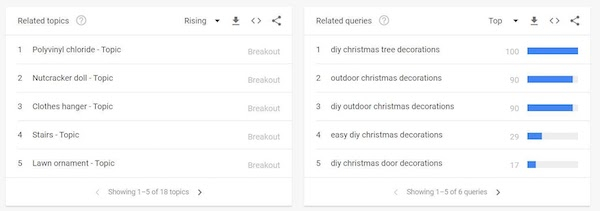
Once you have a topic in mind, the next thing to turn to is your focus keyphrase. Your focus keyword/keyphrase is a word (or group of words) relevant to your topic. It needs to appear in your title, URL and throughout the body of your text, and is actually the hook to getting your content found on search engines without needing to pay for promo. It’s basically what users type into search to look for content.
If you pick a keyphrase that has a high search volume but low competition, chances are (given that you produce a high-quality article) that Google will promote your article over your competition on search.
The best free tool for this is Google Keyword Planner. Intended for paid ad campaigns, you can type your idea into Google Keyword planner either to discover new keywords or to see search volume and forecasts for a keyword you already had in mind. You can apply various filters, like location, language, search network, and much more.
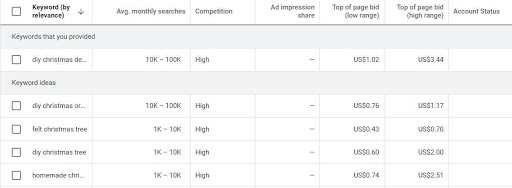
Now that you know how to get the body of your text squared away, you’ve got to come up with a good title. According to statistics, eight out of 10 readers won’t get past much more than the title, so you need to put focus on having a catchy headline that will intrigue your audience enough to actually click on the article and scroll through.
Experiencing a creative block? Just paste your keyphrase into Portent’s title maker and let it do the work for you.
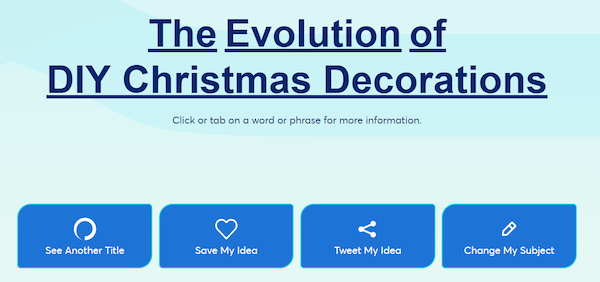
Refine your structure
Structure in an article is everything. If you want it to be readable and SEO-friendly, you can bet that a one-paragraph, 1000-word essay ain’t it. It’s best to think about structure as you’re planning your content instead of trying to separate things later.
The best free content writing tool for getting inspiration for your structure isn’t a content writing tool at all, it’s Google. Look up your keyphrase and take a peek at other websites that are writing about your topic. If the highest-ranking articles are “top XY” lists, then you’d perhaps want to make a “top XY” list, as well.
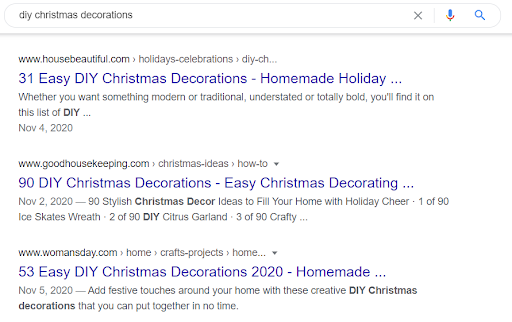
Your next best friend in the free content writing world is YOAST. Most people know YOAST as that handy-dandy WordPress plugin, but what many don’t know is that YOAST also has a real-time content analysis tool you can simply copy-paste your text into. YOAST not only helps you out with technical content assessment and structure, but also reviews how well you put together your title, URL, meta description, how densely you distributed your focus keyphrase and performs a full-on SEO check. It also allows for a snippet preview so you can see what your article is going to look like on search results. YOAST also gives you a little pep talk when you optimize your content according to their checklist.
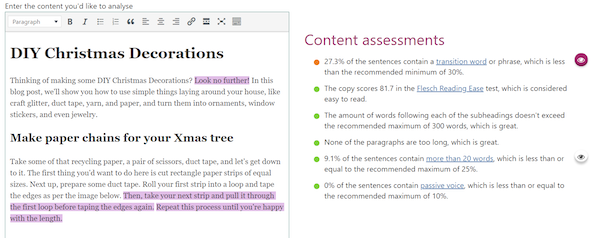
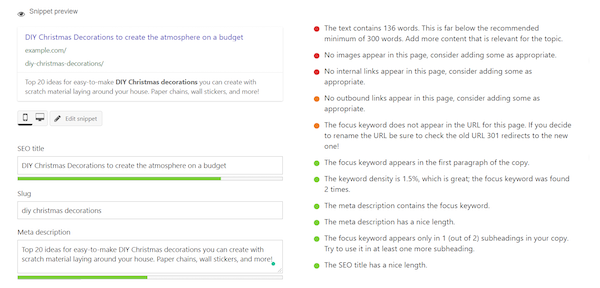
Another great free content writing tool for checking your structure and SEO is Word Counter. Aside from just counting your words (as the name would imply) Word Counter also gives you an idea of the reading time and reading level, as well as pulls out all keywords you put in your text and lets you know how you distributed them (as overuse of keywords is as bad as underuse).
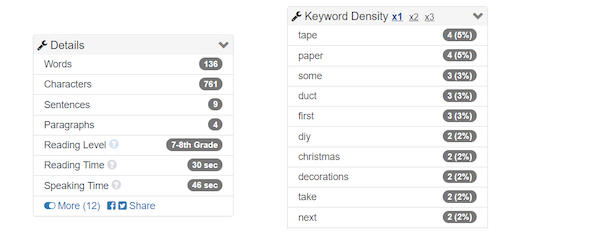
Readability and originality
Having touched on readability – good grammar and phrasing don’t necessarily impact SEO, but they can greatly impact user experience. For example, if your topic is “DIY Christmas decorations”, but you’re writing academic-level 100-clause sentences, that’s not gonna fly for 45-year-old Martha who just wants a simple tutorial on how to make an origami snowflake.
The best free content writing tools to nail your readability score are Grammarly and the Hemingway App, and they are best used together like PB&J.
First, install Grammarly’s free browser extension. Next, hop onto Hemingway and paste your text there. Grammarly will underline any Grammatical errors. In addition to giving you a run-down of the reading time, characters and words (like Word Counter), Hemingway will highlight any readability issues, like using a difficult vocabulary, overuse of adverbs and sentences that are (very) hard to read. The perk of Hemingway is that you can edit your content in the app until you’re satisfied with your results and you get rid of those pesky highlights.
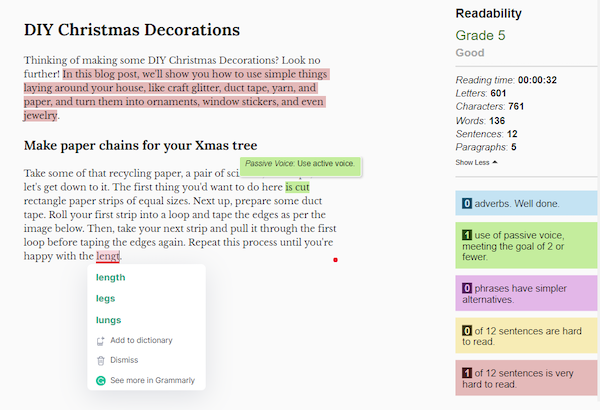
As a final point, remember – do NOT steal content. If putting somebody else’s thoughts in your text seems appropriate, then reference the author and/or link the source. If you’re paraphrasing information found elsewhere, then make sure you aren’t using the exact words as somebody else. After you’re done writing your article, give it a final run-through in Plagiarism Detector to ensure your content is 100% (not even 99%, but 100%) unique.

Do you have some free content writing tools we haven’t touched on? Share them with us by tagging us in a social post! (Twitter, LinkedIn, Facebook)
